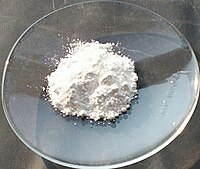
Photo from wikipedia
Abstract In this paper, poplar leaf is used as a template to synthesize hierarchical AgCl-Ag-ZnO composites via a calcination method. Zn(NO 3 ) 2 and AgNO 3 are selected as… Click to show full abstract
Abstract In this paper, poplar leaf is used as a template to synthesize hierarchical AgCl-Ag-ZnO composites via a calcination method. Zn(NO 3 ) 2 and AgNO 3 are selected as precursors. During the calcination of the templates, Zn 2+ ions react with oxygen to produce ZnO nanoparticles (NPs), Cl − ions in leaf cells combine with the external Ag + ions to form AgCl, and Ag + ions are reduced by reducing agents in leaf to Ag NPs. The morphology, structure and visible-light response of the as-prepared hierarchical AgCl-Ag-ZnO composites are determined. The composites exhibit a strong photocatalytic activity toward the degradation of Rhodamine B (RhB) under visible-light irradiation. The AgCl-Ag-ZnO composites display an enhanced photocatalytic activity, compared with the leaf-templated AgCl-Ag and ZnO. A photocatalytic mechanism is proposed, based on the efficient separation of photoexcited electron-hole pairs due to the surface plasmon resonance (SPR) effect of metal Ag.
Journal Title: Materials Research Bulletin
Year Published: 2018
Link to full text (if available)
Share on Social Media: Sign Up to like & get
recommendations!